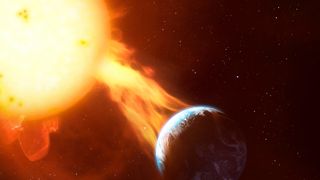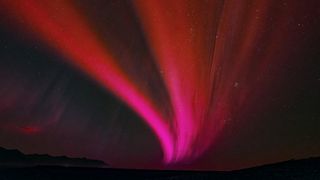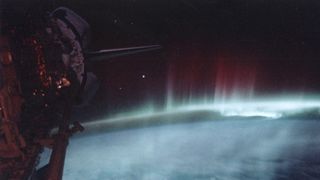What if the Carrington Event, the largest solar storm ever recorded, happened today?
If a solar storm as big as the Carrington Event struck today, it could lead to years long power outages.

In 1859, British astronomer Richard Carrington saw a blast of white light on the surface of the sun. This was the Carrington Event, as scientists now call it, and it is the largest recorded solar storm ever recorded. It was linked with extraordinary auroras — the Northern and Southern Lights — that were visible in the sky near both the poles and the equator, everywhere from Canada to Australia.The enormous solar outburst also caused electrical disruptions from Paris to Boston.
While the Carrington Event may seem like history, there are many concerns about what might happen if an event as powerful as — or even more powerful than— the Carrington Event were to strike Earth today, now that humanity is far more dependent on electricity.
Related: Could a solar storm destroy Earth?
The 1859 Carrington Event
On Thursday, Sept. 2, 1859, at roughly 11:18 a.m. in the town of Redhill outside London, Carrington was investigating a group of dark specks on the sun known as sunspots, when he detected what he later described as "a singular outbreak of light which lasted about five minutes."
This was the first solar flare ever seen and reported, according to a 2016 study in the journal Advances in Space Research.
Magnetic sensors at the Kew Observatory in London detected extraordinary magnetic disturbances on Earth from Aug. 28 to Sept. 7 that year, especially on Aug. 28 and Sept. 2. These coincided with what may arguably have been the most intense auroras in the past 160 years, the 2016 study noted.
"Luminous waves rolled up in quick succession as far as the zenith, some a brilliancy sufficient to cast a perceptible shadow on the ground," the Times of London reported on Sept. 6, 1859.
The colorful displays were so bright that people in Missouri could read by the atmospheric light after midnight, according to an 1859 report in the Weekly West newspaper. Gold miners in the Rocky Mountains woke up and made coffee, bacon and eggs at 1 a.m. local time, thinking the sun had risen on a cloudy morning, according to the National Oceanic and Atmospheric Administration (NOAA).

The Northern and Southern Lights usually appear near the planet's poles. However, during the Carrington Event, people witnessed the auroras all the way in the tropics, including in Cuba, Jamaica and Panama, the 2016 study noted.
Auroras were also seen in the southern hemisphere. For example, in Moreton Bay in Australia, "most of our readers saw last week, for three nights, commencing after sunset and lighting up the heavens with a gorgeous hue of red, the Southern Aurora," according to a report in the Moreton Bay Courier on Sept. 7, 1859, the 2016 study noted.
Meanwhile, telegraph lines experienced "one of the most startling as well as singular electrical phenomena," when "a superabundance of electricity in the air" enabled telegraph machines to send messages from New York to Pittsburgh without the aid of batteries, according to the Washington Star in 1859.
Sparks flew from telegraph machines in Paris, according to a report in the The Illustrated London News dated Sept. 24, 1859, and telegraph operator Frederick Royce in Washington, D.C. reported receiving "a very severe electric shock, which stunned me for an instant," The New York Times reported on Sept. 5, 1859. "An old man who was sitting facing me, and but a few feet distant, said that he saw a spark of fire jump from my forehead."
All in all, the Carrington Event affected almost half of the telegraphic stations in the United States, according to the 2016 study.
What caused the Carrington Event?
Solar flares, the largest explosive events in the solar system, are intense eruptions of plasma and radiation associated with sunspots, according to NASA. The sun unleashes solar flares when magnetic energy that builds up on our star gets suddenly released, Hugh Hudson, a solar physicist at the University of Glasgow in Scotland, wrote in a 2021 study in the journal Annual Review of Astronomy and Astrophysics.
Solar flares are often accompanied by the release of giant bubbles of solar material, known as coronal mass ejections (CMEs). These eruptions may contain billions of tons of plasma — clouds of electrically charged particles — that can race out at millions of miles per hour, NASA noted.
Hudson's 2021 study estimated that the radiation from the Carrington flare likely carried about 4 X 10^32 ergs of energy, which is about as much as 10 billion 1-megaton nuclear bombs. He also estimated that the event's CME likely carried about 3 X 10^32 ergs of kinetic energy.
The Carrington Event triggered a geomagnetic storm on Earth, Hudson noted in his study.
The explosion likely spat out a coronal mass ejection that blasted our planet with high-speed gusts of super-heated plasma clouds, which had intense magnetic fields embedded within them. When such outbursts slam into Earth's magnetosphere — a shell around the planet that holds plasma trapped by Earth's magnetic field — this plasma can flow down the planet's magnetic field lines and smash into molecules in Earth's atmosphere, resulting in auroras.

Solar flares can also trigger intense electrical currents in the magnetosphere, according to NOAA. These currents may in turn generate magnetic disturbances in the ground on Earth, which can produce electrical currents in long stretches of electrically conductive material, such as power lines, telecommunication cables and pipelines.
Geomagnetic storms have the potential to wreak havoc on Earth. In 1989, a geomagnetic storm blacked out the entire Canadian province of Quebec in 90 seconds, leaving 6 million customers in the dark for nine hours, according to NASA. It also damaged transformers as far away as New Jersey—including one at a nuclear power plant—and nearly took down U.S. power grids from the Eastern Seaboard to the Pacific Northwest.
Geomagnetic storms can also disrupt radio communications and GPS navigation by warping the atmosphere in ways that modify the paths of radio signals, NOAA noted. For instance, the Halloween Storm of 2003 prevented the Federal Aviation Administration from providing GPS navigational guidance for roughly 30 hours, according to a 2011 study for the U.S. Department of Homeland Security.
Solar plasma can also heat the planet's upper atmospheric layers, making them swell and potentially drag down satellites in low Earth orbit, NOAA said.
What would a Carrington Event do today?
The world has become far more dependent on electricity than it was when the Carrington Event occurred. If a similarly powerful solar flare that was pointed at Earth — as opposed to away from our planet, where it would not have any direct consequences for our world —were to explode now, it might cause unprecedented damage.
For example, a 2013 study from British insurance giant Lloyd's of London estimated that electrical outages from a Carrington-level event might lead to up to $2.6 trillion in lost revenue for the North American power industry alone. The study also found global blackouts up to years long might occur because such an event could simultaneously damage multiple extra-high-voltage transformers that are difficult to replace. This could in turn result in major disruptions to financial markets, banking, telecommunications, business transactions, emergency and hospital services, the pumping of water and fuel and food transport.
Similarly, a 2017 study in the journal Space Weather found that in the most extreme blackout scenario, impacting 66% of the U.S. population, the daily domestic economic loss could total $41.5 billion plus an additional $7 billion loss via international supply chain disruptions. In contrast, if it only affected extreme northern states, which are home to 8% of the U.S. population, the economic loss per day could reach $6.2 billion supplemented by an international supply chain loss of $0.8 billion. (The study calculated using 2011 U.S. dollars.)
However, although the Carrington Event was powerful, "we have seen comparable events since then," Hudson told Live Science in an email. For example, two of the so-called Halloween solar flares of 2003 may have each emitted comparable amounts of radiated energy as the Carrington Event.

As such, Hudson suggested that a solar flare on the level of the Carrington Event might not pose as big a threat to humankind as some fear. Still, a Carrington Event pointed at Earth today "would have substantial impacts, mainly on human activities in space." Hudson said "We do not have much practice for such an event, because the space assets haven't been exposed to an event of this magnitude yet.” Indeed, Apollo astronauts have made their lunar excursions in the midst of solar activity — “it was on a lesser scale, but still very dangerous to unprotected humans in space," Hudson noted.
In addition, there is evidence that the sun may be capable of "superflares" that can unleash 10 times or more energy than the Carrington Event. For example, in a 2021 study in the Astrophysical Journal, scientists using NASA's now-retired Kepler space telescope found that over the course of four years, 15 sun-like stars released 26 superflares packing a wallop up to 100 times greater than the Carrington Event. A 2020 study in the Astrophysical Journal found similar results during the first year of NASA's ongoing TESS mission.
Moreover, scientists analyzing tree rings detected evidence of radioactive carbon-14 atoms — which each possess two more neutrons in their nuclei than regular carbon atoms — from solar explosions. Spikes of carbon-14 seen in the years 660 B.C., A.D. 774 and A.D. 994 may have come from superflares that were significantly stronger than the Carrington Event, Hudson said.
"The notable thing is that even the Carrington event, or comparably large normal events, are not detectable by the carbon-14 technique," Hudson said in the email. "So these ancient records are ominous."
When will the next Carrington Event occur?
A study published Feb. 29, 2024, in the journal Space Weather looked at digitized copies of magnetic field recordings from 1859 to estimate the strength of the Carrington Event. Based on the readings, the researchers concluded that Carrington-level events likely occur once every 100 to 1000 years. However, without knowing exactly how powerful the event was, scientists can only make educated guesses about how common solar outbursts of its kind may be.
The 2021 Astrophysical Journal study analyzing Kepler data suggested that superflares about 10 times more energetic than the Carrington Event may happen about every 3,000 years, and ones about 100 times more energetic may occur about every 6,000 years. Still, the rates at which our sun in particular may release Carrington-like or more powerful flares "are not well understood," Hudson said.
When it comes to solar explosions that can release major spikes of carbon-14 atoms seen in tree rings, scientists now know of at least a half-dozen "scattered through the Holocene, a 10,000-year time scale," he noted. However, "we do not understand how these are related to normal solar eruptive events such as Carrington's, and until we do, all bets are off, I'm afraid."
Editor's note: This article was updated on March 26, 2024, to include new information about the Carrington Event's strength and the likeliness of similar events occurring again.
Sign up for the Live Science daily newsletter now
Get the world’s most fascinating discoveries delivered straight to your inbox.

